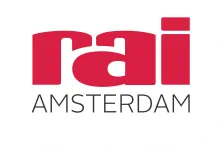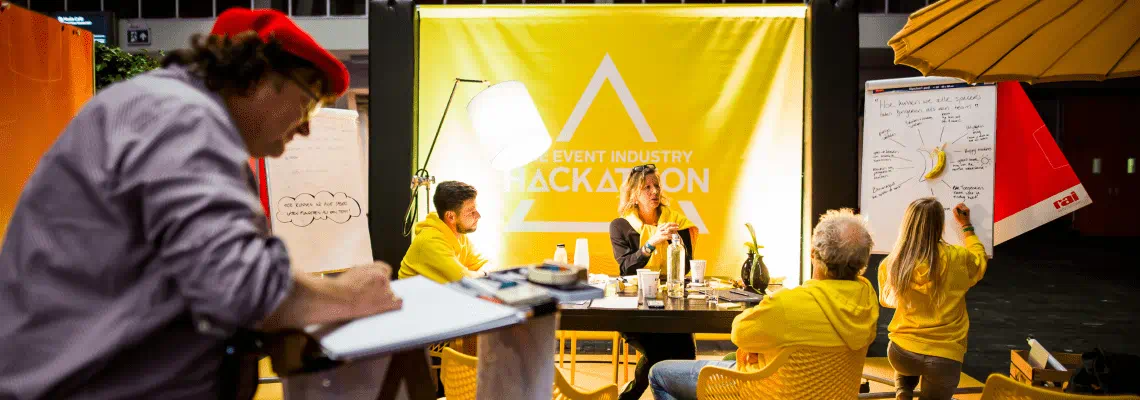Why not organise a hackathon during your next event? It stimulates innovation in the sector, attracts a new target group and adds significant dynamics to the event. We recently organised our first hackathon and are pleased to share our experiences with you.
As an event organiser, your tasks involve far more than organisation alone. In many cases you also act as a moderator or initiator of a community. So how do you combine these tasks? You can’t always see what’s brewing among your participants or members, which means you don’t always know which innovations or ideas are being shared. With a hackathon as (sub)event you can attract new target groups to your event and generate fresh answers to the issues at play in your sector.
The importance of innovation
As RAI Amsterdam believes in the importance of innovation in the event industry, we continue to challenge ourselves and the sector as a whole. With this in mind, we organised a hackathon from 31 October to 1 November. With 50 hackers in eight teams resolving four critical issues in the event sector in just 24 hours, the hackathon produced some great ideas. It was also an excellent way to explore the opportunities that a hackathon offers as an inspiring vehicle for adding an extra dimension to your event.
Relevant issues
The four challenges addressed in our hackathon revolved around sustainability, experience, matchmaking and logistics in relation to events. In the daily hustle and bustle, organisers rarely have the opportunity to approach these issues from a strategic point of view. This is why we brought people from very different backgrounds together, including programmers, scientists, students and professionals from the Netherlands and abroad. The cross-pollination between disciplines acted as a catalyst for ideas, while we provided a 24-hour pressure cooker and a structured innovation technique based on the Dutch Design Thinking innovation method.
Design Thinking
Hackathons are often associated with solving IT-related issues, but they can easily be used in other frameworks too. Do make sure that your creation benefits from a clear direction and structure. One well-known approach involves the Design Thinking method, which focuses on the individual and takes the same steps again and again: empathise, define, ideate, prototype and test.
Various parties are specialised in this method and can guide the process as a moderator. We worked with Studio.Why, for example. Moderators are crucial to get the process going, steer it in the right direction and dislodge things when they get stuck. Other important ingredients of a successful hackathon are an inspiring environment, the right ambiance, breaks to relax the mind and healthy catering that can keep people active for 24 hours. To ensure these aspects were present we also involved various professional partners.
Everyone’s a winner
The winner was the ‘From purple to virtual’ team, which came up with a concept in which modular stand construction was enriched with an interactive digital world. The stand construction elements are all reusable, placed in the space by robotic arms and delivered and removed by robots too. This limits the number of logistic movements and, at the same time, offers many opportunities. The concept won the team the honours and a tidy sum of €2,500 euro for a charity of their choice. And that was just the start. Because when the hackathon ends, the development of the idea starts in reality. When you organise your own hackathon, consider the extent to which you wish to be involved in this process.
New community
The hackathon had several other results, including the birth of a new community that we can invite again during the next edition, a change in the mindset of the participants, and more new ideas in the slipstream that could be of interest to the entire sector.
What can a hackathon mean for your event?
First: A hackathon within an event can add unique dynamics that make the event extra attractive to visitors, exhibitors and sponsors. It also teaches the participants, visitors and yourself to look at challenges in a new way. This is not an unnecessary luxury in a world that is changing at breakneck speed.
Second: A multidisciplinary participant group, combined with a method like Design Thinking, will result in more new ideas than ‘traditional’ innovation contests. Challenges are approached from various perspectives, leading to inspirational results.
Third: The outcomes are interesting and may result in new opportunities for the business and/or sector in which you’re active, In addition, you’ll generate extra publicity for your event.
In other words, we are looking at a win-win-win-win situation. ‘Hackers’ are given a platform for their smart ideas and can make valuable contacts that will help them further develop their concepts. Companies that contribute challenges receive innovative answers to urgent matters and are closely involved in the process. Visitors are given a more interesting event and continue to be engaged after the event by the results – which in some cases may actually be realised. Last but not least the event itself benefits from new ideas, additional publicity and an all-round better experience.
Tips for a successful hackathon
After our own first edition, we can conclude that the following tips will help you make the most of your hackathon.
Tip 1: Invite your sector and network to submit challenges in advance and involve the right experts and/or event visitors to act as a sounding board for the hackers during the hackathon itself. This will help generate maximum engagement and interest.
Tip 2: Approach the broadest possible group of hackers, such as scientists, students, experts from the sector, trendwatchers, designers, you name it… Everyone can participate in a hackathon! Profession, education, background – it doesn’t matter. The more diverse, the better. Create teams of people from varying disciplines and classify them in specific roles, helping ensure that complementary personalities strengthen each other.
Tip 3: A basic rule for every hackathon is to provide the right innovation method and consider the programme carefully. This will help people step outside their comfort zone, be eager to achieve results and maintain the right flow. Also ensure you have the right facilitators who guide the teams to ensure they don’t get lost.
Tip 4: Create a good atmosphere with a comfortable work space, and proper decor, lighting and sound. Provide good-quality catering and niches where people can relax or take a powernap.
Tip 5: Deliver the right social media coverage and capture the hackathon well, in photos and on film. The dynamics are very infectious and work especially well in moving images. Build the tension via social media as well. For our hackathon we saw social media explode, partly due to the hard work of our social media partner Live Online Events, but also thanks to the genuine enthusiasm and shared experiences of the participants.
Tip 6: Use the available data. If there are developers involved, you’ll be surprised at the patterns they’ll discover using data. Do make sure that the data is anonymised and that privacy is guaranteed in accordance with the applicable legislation.
Tip 7: Realise that your ideas are not the end game but just the starting point. Ask yourself in advance how you would be able to and wish to support any ideas resulting from the hackathon.
Tip 8: Share the results; this is not just your party, it’s a way to help your field or sector move forward.
And most importantly: get to work! Everyone will have their first hackathon at some point, and that includes us. Don’t be afraid, enjoy the dynamics and the people involved, use the results and learn from the process so that you can do even better second time around.
I would love to hear about your experiences so far. Ready to share?

